Stalag 18A

Stalag 18A |
 |
For most of the details of Stalag 18A, I am indebted to three ex-inmates: Eric Fearnside,
Ken Willmott and Ken O'Kennedy. Eric was a driver in the Royal Engineers who got away from Greece at the small port
of Navplion, but was later captured in Crete.
Eric's book contains a lot of detail of the day-to-day life in the camp, in particular the concerts and other entertainments.
Sadly, Eric died in 1998.
Ken Willmott was in the Fourth Hussars and was captured at Kalamata. He was a musician and,
like Eric, was heavily involved with camp entertainment.
Ken O'Kennedy was a Signalman. He was captured in Crete, spent 2 years in Work
Camp 1107/L before returning to Stalag 18A. He was heavily involved with the
Theatre.
 |
Map of Austria. | Plan of Stalag 18A. |  |
Whether a soldier was captured in Greece or Crete, the next few weeks had a grim similarity. On foot, by road, rail or sea, he would eventually be taken to a temporary camp in Salonika. From there, he would be packed into a railway wagon designed for carrying cattle, with fifty other prisoners of war. There followed days of hunger, thirst and lack of sleep as the train made its slow way up through Yugoslavia to southern Austria and the final destination of Stalag 18A at Wolfsberg. (For some, the journey ended at Stalag 18D in Marburg. When this camp closed, most POWs were transferred to Stalag 18A.)
(For a detailed account of the journey from the POW camp at Corinth in Greece to Stalag 18A, click on The Road to Wolfsberg.)
A prisoner did not usually stay long in Stalag 18A, as it was a clearing camp for scores of working camps throughout Austria. Within a few days he would be assigned to a Work Party (Arbeitskommando), normally of 15 to 20 men, and sent on. The 'lucky' ones would be assigned to farm work, where there was a least a chance of adequate food. The less fortunate might be sent to an iron mine, a quarry or a timber mill, where the hours were long and the work hard.
Click on any picture to go to that Section
So what made Stalag different from a working camp? Well, ARBEIT, of course. But Senior NCO’s and WO’s didn’t have to work according to the Geneva Convention. Officers too; their camps were much more security-minded than those for the ranks. It was most probably a German belief that officers were much more intelligent and therefore more able to plan sophisticated disguises, tunnels etc.
In Wolfsberg there were quite a lot of people hanging around. Some of them didn’t exist; their names had been removed from an index by (allegedly) the Phantom (believed to be a certain Joe Gretton), foolishly entrusted with this job The so-called Inner Circle was responsible for giving the Germans a sufficient supply for the working camps, but they were also capable of ensuring that valuable labour was kept in Stalag; for example for the theatre – musicians, actors of all kinds, electricians, art designers, tailors, carpenters, writers and for the care of the sick – medical orderlies, doctor’s assistants.
What to do to pass the time? Sport? Well, soccer was taken very seriously from a regional point of view. Interminable running round the area known as the sport field. But the greatest game of all was Australian in origin – no, not cricket or rugby. There was always a ring of people somewhere uttering strange cabalistic noises, such as- ‘ten he heads ‘em, get set on the side, come in spinner!’ TWO-UP, they called it. So what do you gamble with? On the working camps, men were paid “Lager Geld” of RM18.20 per month, blissfully ignorant that after the war they would be redeemed at face value.
And talking about face value…trading laws were necessary. Economists declare that money must adhere to at least three rules – acceptability, divisibility and limited in quantity. Lager Geld was OK for some, but certainly not to the French, etc. Cigarettes filled the bill. So by international agreement the day’s rates were pinned up on a barrack wall for all to see.
To facilitate communication a language was devised – Lager Deutsch – not only for trading. e.g. "Du kommen round miney barrack, ik gibben du shockolade – du habben Cigaretten??" It was even understood by some Germans. An example: from time to time German security officers wandered round the camp. One of these was a Sonderfuehrer with the unfortunate last name of LAUSE. Allegedly he was in civilian life a university professor who spoke faultless English.
Scene – an interview with a middle-aged Londoner who had served in WW1, Darky Marsh by name.
Marsh: “Ere comes Lousy – what the f--- does 'e want?
Lause: “Why cannot we be civil to each other, Mr. Marsh? I see from your jacket that you have medals from the Great War. As you see from my uniform, I too have the medals which show that I was there too.
Marsh (unwilling to share the moment and the language, after a pause for consideration)
“Miney medals real medals. Du medals Ersatz medals.
Lause : (Departs with reluctant sigh.)
Religion? There were of course no church parades, no line-up in column of threes followed by “Fall out the other denominations”. There were however three interesting Ministers: Father Juneau, an S.J. Roman Catholic, Rev. Hobling a very nice man reminiscent of a village curate, who was killed in the December 1944 bombing, and “Padre” John Ledgerwood of the YMCA, often to be seen in the theatre and also in the Two-up ring. All of them conducted services of a sort in the theatre with a modest following.
So was 18A like a Butlin’s Holiday Camp? Well, compared with the working camps and their long working hours laying roads, breaking stones with 3-kilo hammers, perhaps.
For some however it was the boredom, the waiting for Red Cross Parcels and news from home that affected their minds. But most of us got back, to be told “War’s not over yet. Get retrained for Far East!!!”
But we weren’t – we weren’t needed any more.
(Ken O'Kennedy)
The British & Commonwealth POWs in Stalag 18A printed a newsletter, POW WOW. This is the first edition, printed in December 1941. It was brought home by L/Bdr Tom Watson, Northumberland Hussars.
 |
 |
 |
 |
 |
 |
 |
 |
| Group 11 | Group 13 | Group 14 | Group 15 |
 |
 |
 |
 |
| Group 16 | Group 17 | Group 19 | Group 20 |
 |
 |
||
| Group 21 | Group 22 |
 |
 |
 |
 |
| Latrine call (PE) | Char (PE) | Church Service (DF) | Home Brew (DF) |
 |
 |
 |
|
| Hut interior | Hut interior | Hut interior | |
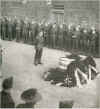 |
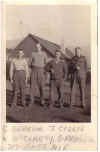 |
 |
 |
| ANZAC Day 1943 (JG) | 2/7 Inf. Bn. AIF Group (SF) | George Fraser Group (SF) | The Secret Still |
 |
 |
 |
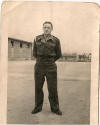 |
| Vic Beardow | Michael Farrington | 'Sherry' Cooper Group | Joseph Conn aka J. Orr |
 |
 |
 |
 |
| Frank Morris on right | Yves Fontaine | Denis Powell | Tom Carpenter |
 |
 |
 |
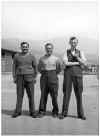 |
| James Rennie group | Eric Fernside, Eric Curtis | Percival Greig group | William Eastwood group |
 |
 |
|
 |
| Tommy Oldfield | Tommy Oldfield group | Lionel Bigmore & Bill Perry | J. O'Connor & Unknown |
 |
 |
 |
 |
| Jack Swinnerton | Jack Swinnerton group | Dick Bushby | Dykes, Hale, Doolan, Wishart |
 |
|
 |
 |
| Unknown | Henry Hillier | Stan Peters group | William Wells |
 |
 |
 |
 |
| French POWs (PE) | John Gibb | John Gibb Group | T.D. Jones Group |
 |
 |
 |
 |
| F.W. Maclaren | F.W. Maclaren group | Hut interior 1 | Hut interior 2 |
 |
 |
 |
 |
| Vic Beardow Group | (Phil McWilliams) | James Rennie group | James Fall group |
 |
 |
|
|
| James Fall | Unknown group | 106 RHA group | Liverpool group |
|
|
|
 |
 |
| Unknown pair | Dick Rimmer | Les Hudson | Les Hudson & Unknown |
 |
 |
 |
 |
| Stanley Peters group | Capt. Crowe group | Charles Cleves group | James Shaw group |
 |
 |
 |
 |
| Capt. Crowe, M.O. | Capt. Crowe group | Crowe, Juneau, Unknown | Juneau + unknowns |
 |
 |
 |
 |
| Dick Horan group 1 | Dick Horan group 2 | Dick Horan group 3 | 4 Fld. Amb. NZMC group |
 |
|||
| Stan Peters group | |||
 |
|
|
|
| Officers group (inc. Capt. Beattie) | View of hospital from Hut 3 | Ken Faulkner group 1 | Ken Faulkner group 2 |
 |
 |
 |
 |
| (Phil McWilliams) | Jean Siviere group (French) | Eric Curtis group 1 | Eric Curtis group 2 |
 |
 |
 |
 |
| Bill Pinder | Fred Kenney on right | Finlay Campbell | Eric Evans group |
 |
 |
|
 |
| Arthur Green on right | Charles Cleves | Doug Arthur group | Les Hudson group 1 |
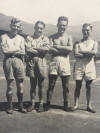 |
 |
 |
 |
| Les Hudson group 2 | Keith Newport group 1 | Keith Newport group 2 | Keith Newport group 3 |
 |
 |
 |
 |
| Albert Phelps group 1 | Albert Phelps group 2 | Albert Phelps group 3 | Albert Phelps group 4 (Two-up) |
 |
 |
||
| Albert Phelps group 5 | Albert Phelps group 6 |
SSM Cooper, RAC, was Camp Leader at Stalag 18A. He can be seen in most of the large group photos shown above. The following photos were sent by Vel Edwards-Hier, his daughter. The German officer in the third photo is probably Oberstleutnant von Reckow.
Stuart Fraser of Australia has sent the following set of photographs, brought back by his father, CQMS George McKenzie Fraser, 2/7 Inf. Bn. They appear to show a Boxing and Wrestling Tournament with contestants from the British and French camps. The event probably took place in April 1943 (although the dedication on one photo is dated 2.10.43).
 |
 |
 |
| Stan Huitson | J. Vernon | Unknown |
 |
 |
 |
| Nipper Smith | Jim Miller | Albert Drew |
 |
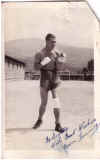 |
 |
| John Moore | Thomas Cameron | Stanley Young |
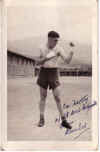 |
 |
 |
| 'Bomber' | Percy Shaw | Henri le Grand |
 |
 |
 |
 |
 |
|
 |
 |
 |
| Tournament 1 | Tournament 2 | Tournament 3 |
 |
 |
The following three photographs are also courtesy of Stuart Fraser.
The score cards from two Test Matches: Australia v England and Australia v New Zealand, played in September 1943, along with the ball used. Supplied by Ian Davey, grandson of John Davey.
 |
 |
 |
 |
 |
 |
 |
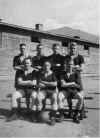 |
 |
| Robert Dickson group | Herbert Hook group | |
 |
 |
 |
| NZ Rugby Team | Edgar Miller group | |
 |
 |
|
| Les Hudson group 1 | Les Hudson group 2 | |
 |
||
 |
 |
 |
Often the German guards would know that a particular Shadow man was in the
camp and warn him if the Gestapo were about to conduct a search with dogs. Next
to the Delousing Hut was a small hut known as the 'LZ' that housed ill and
disabled POWs. Underneath this hut was an escape tunnel where the Shadow men
could hide until the search was over.
At the
working camps news was scarce; perhaps one or two larger camps may have cobbled
together a radio, but mostly all that was heard was from local work gaffers who
insisted – until about summer 1944 – that they were clearly winning the war. But in
Stalag, there was:
THE NEWS
- At first a squad wandered round each barrack with a brief report
summarized from the hidden radio. Later
however, the presentation was given in the theatre rivalling today’s BBC’s
Peter Snow explaining election trends. The peripatetic version was maintained by
a Kiwi sergeant, Hec Myers whose version was from the same source, though
sometimes we wondered; viz: “Last
night many fires were started in Hamburg after the RAF dropped insanitary
bombs.”
Then of
course there were rumours and s***-house rumours, of varying content
‘Pakete
morgen’ (Red Cross parcels tomorrow)-
sometimes true
‘Hauptmann
Schaefer (the Security boss) has asked the SS to take over the camp.’
Never noticed it.
‘The
Americans are only ten miles away’-
the Long March contradicted that one.
Give a
medal to the lads who built the radio -
they kept the morale up!
There
were also the German loudspeakers that from time to time would give their
versions of air battles in Britain:
Germany:
We shot down 846 RAF fighters. Our losses were 15.
Britain:
55 German bombers shot down, or badly damaged. 20 fighters lost.
Take your choice – BBC or Goebbels.
(Ken O'Kennedy)
![]()